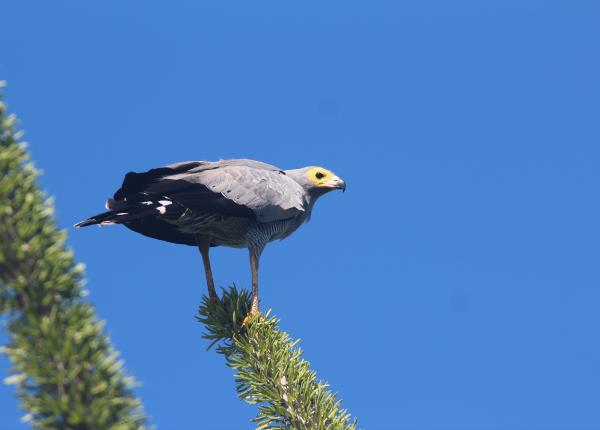Did You Know?
- The Madagascar Harrier-hawk is also known by a few other names, including Banded Gymnogene or Madagascar Gymnogene
- Researchers documented this species feeding the pulp of oil palm fruits
- The Madagascar Harrier-hawk is one of the five most common raptor species in Madagascar
How The Peregrine Fund is Helping
The Peregrine Fund is working tirelessly in Madagascar to save habitats and biodiversity. Three of 24 Malagasy raptor species are endangered, but thankfully the Madagascar Harrier-hawk isn't one of them. One of the most important actions we can take to save species is the preservation of suitable habitats. In 2015, after years of working with local communities and government, The Peregrine Fund helped create three new areas which were given status as "National Protected Areas." This victory has increased protected habitat by 190,000 hectares and will provide protection for an untold number of endangered species.
Where They Live
The Madagascar Harrier-hawk is endemic to Madagascar. This means it is found there and nowhere else on Earth! Within Madagascar, it makes its home in a wide variety of habitats. It can be seen soaring over montane rainforest or spiny desert scrub, or perhaps perched, or on the hunt, in both primary and degraded forests, as well as wooded habitats, dies, wetlands, rice paddies, and exotic tree plantations.
Why They Need our Help
Thankfully, the Madagascar Harrier-hawk is categorized as a species of Least Concern. This is probably because this hawk is fairly common in the eastern and northeastern forested portions of Madagascar, and so researchers aren't worried about this species' survival. Additionally, this raptor seems to be quite adaptable to some changes in its habitat, which means it has a pretty good chance of surviving. However, that doesn't mean it isn't facing threats throughout its range. In fact, extreme deforestation could be a huge problem for this species in the long-term. Additionally, Peregrine Fund biologists documented one occasion that villagers had trapped, killed, and eaten a harrier-hawk that had preyed upon their chickens.
What They Eat
The Madagascar Harrier-hawk is not a picky eater! It will prey upon a long list of different animals using a number of different hunting techniques. Small lemurs, flying foxes (which are actually bats), geckos, chameleons snakes, amphibians, mice, tenrecs, locusts, beetles, cockroaches, and other insects are all on this bird's menu. It will even feed on other birds - including their eggs and nestlings, such as parrots and doves. It also feeds on domestic fowl.
Just about now you might be wondering how one hawk can catch so many different types of prey. When on the hunt, this raptor might climb along termite mounds, tree trunks, limbs, and epiphytes, grasping a branch and balancing itself by flapping its wings as it peers into holes or under leaves, and reaches into crevices with its long legs. It often finds small prey, such as lizards, in this way, but it can also come across sleeping, nocturnal lemurs that it will feed on. When not scrambling among the trees, it soars slowly between them, using its keen eyes to spot prey moving below. It will even spend time strolling along on the ground, turning over dung or sticks and leaves to find beetles or other insects for it to eat.
Nest, Eggs, and Young
Though more observations need to be made, it seems that Madagascar Harrier-hawks engage in beautiful, aerial courtship displays, at the beginning of breeding season. The female is the primary nest builder and she will collect sticks which she fashions into a shallow cup-shaped nest high up in the fork of a large tree, such as a baobab or acacia. Researchers have noticed that Madagascar Hawk-Harriers will often build their nests in close proximity to colonies of weaver birds. They will sometimes build their nests on cliff ledges. These hawks will often reuse the same nest in consecutive years.
When the time is right, the female will lay up to two eggs which are off-white with reddish-brown spots. The eggs will need to be incubated for around 39 days. The female will take on this important task, while the male will be responsible for finding enough food to feed his growing family. While both eggs often hatch, Peregrine Fund biologists have documented that these nestlings may engage in siblicidal behavior. This means that the older, bigger nestling will kill its younger, weaker sibling. By the time the surviving nestling is 50 days old, it will be ready to fly from the nest for the first time.
Researchers don't yet know how long a young Madagascar Harrier-hawk will remain with its parents before it is able to hunt and otherwise survive on its own.
Madagascar Harrier-hawk and The World Center for Birds of Prey
Though the World Center for Birds of Prey is far away from the Madagascar Harrier-hawk's range, the center still offers fun ways to learn about this raptor and other birds of prey. Interactive activities, tours, interesting videos and a children's room with activities from coloring sheets to quizzes to costumes await you. At our visitor center, you can see many hawks up close and learn about the wonderful and interesting adaptations they have in order to survive in their respective habitats.
References:
Global Raptor Information Network. 2021. Species account: Madagascar Harrier-hawk Polyboroides radiatus. Downloaded from http://www.globalraptors.org on 6 Sep. 2021
Kemp, A. C. and G. M. Kirwan (2020). Madagascar Harrier-Hawk (Polyboroides radiatus), version 1.0. In Birds of the World (J. del Hoyo, A. Elliott, J. Sargatal, D. A. Christie, and E. de Juana, Editors). Cornell Lab of Ornithology, Ithaca, NY, USA. https://doi.org/10.2173/bow.mahhaw1.01
Thorstrom, R., and G. La Marca. 2000. Nesting biology and behavior of the Madagascar Harrier-hawk (Polyboroides radiatus) in northeastern Madagascar. Journal of Raptor Research 34:120-125.










